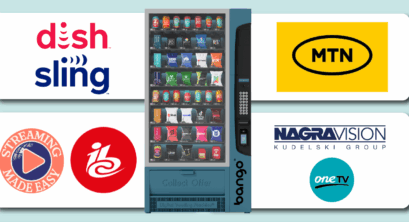A week that proves Super Bundling is here
by Giles Tongue | 16 Sep 2025

Back home at last after a week that was equal parts exhausting and exhilarating. Between IBC in Amsterdam and the launch of Marion Ranchet’s Streaming Made Easy Live, I’ve had more conversations in the past few days than in the last month!
And that’s the beauty of these events: after all the announcements, product reveals and live demos – it’s the human connection – the people, ideas, and the chance encounters that really bring it to life. In these moments, the energy levels rise, creative juices flow, inspiration is unlocked and the road of potential stretches out in front of us.
Three announcements, Three regions, one big theme
We went into the week with news to share, and it ended up being three announcements in three regions:
📺 United States – We kicked things off by announcing that DISH TV and Sling TV have chosen the Digital Vending Machine® (DVM™) to power their subscription bundling. Launching with a football streaming service in time for the new season, DISH customers can now simply add subscriptions to their monthly bill. It’s frictionless, it’s fast, and it shows how sports can drive adoption of new models. Read full press release here.
📱 South Africa – Next up, MTN South Africa became the latest telco to partner with the DVM™, bringing Super Bundling to a new continent. This is a major step forward in making subscriptions more accessible, and in bringing the simplicity of one place, one bill, to millions of consumers. Read full press release here.
🇭🇺 Hungary – And before the events had even started our partners Nagra announced that One Hungary launched with the NAGRA OpenTV® ENTera, platform using the DVM™, creating a secure and scalable way for customers to activate and manage multiple services in one app. Read their full press release here.
Three markets, three announcements, and one common theme: the DVM™ is simplifying complexity and scaling Super Bundling around the world.
Streaming Made Easy Live – a debut worth remembering
Taking place the day before IBC, Streaming Made Easy Live delivered something new and exciting. Congratulations to Marion Ranchet for pulling together such a high-quality audience – the world’s leading subscription video on demand providers Netflix and YouTube both spoke on stage sharing insights usually kept behind closed doors, and some of the leadings telcos were present, including Sling TV and Dish TV, Proximus, Telenet. Also, in attendance were some of leading media commentators, including Evan Shapiro, Alan Wolk and MENA expert Yann Colléter (The Streaming Lab) and StreamTV Insider’s Bevin Fletcher.
As gold sponsors, we were delighted to curate a fireside chat, hosted by Bango chief commercial officer Luisa Muneratti and guest Vincent Stevens from Telenet Group, where they discussed the macro economy for telcos and explored the strategy and choices made by Telenet, who have recently launched their entertainment marketplace that already enables millions of customers to manage their subscriptions in one place. It’s exactly the sort of proof point the industry needs: bundling done at scale, improving customer experience and retention at the same time. See more in our case study here – 26% churn reduction for those taking bundles.
One of the most thought-provoking contributions came from Gregg Bywalski at Webedia, who drew a distinction between influencers and content creators. Influencers, as he framed it, are personalities who find fame – often via reality TV or social media. Content creators are those who originate formats, shows, and IP. It’s a useful distinction, especially as the lines between traditional media, creators, and platforms continue to blur. Often these descriptors are used interchangeably, however with this useful distinction its clear the talent and potential can be significantly different when in the context of the creator economy, media and entertainment.
Themes from IBC: AI, sports, and the pressure for simplicity
AI
AI was everywhere at IBC. Maria Ingold shared an early excerpt from her MSc in AI, a taxonomy, mapping more than 155 use cases across the chain, using categories of Create, Enrich, Deliver, Engage, giving the conversation some much-needed structure.
An eye-catching consumer use case for AI that I heard talked about a few times, is the idea of two agentic-AI systems talking to each other – perhaps you are looking for a holiday, and you set of an agent who then locates and negotiates with another agent, to find you the best deal. This use case could be applicable across many industries – the curation, location, and procurement of products, by an ecosystem of agents talking to each other.
Another use case for AI I liked which is already in the field, is understanding when user behaviour is changing, and anticipating the moment when a corrective intervention would be useful – for example when a user is using a product less frequently, and the AI anticipates a churn risk, and begins protocols such as offering a month free, a discount, or sending additional info about new shows, to prevent that churn.
SPORTS
Live sports and the increasing fragmentation facing sports fans, was another recurring theme.
Till Sudworth from NPAW summed it up perfectly: “If I want to watch Bundesliga, I need DAZN, Sky, and RTL Plus… it’s still frustrating.” Our own data backs that up: in Subscriptions Assemble, 63% of subscribers told us they want a single app to manage all their subscriptions. The message is clear. Fragmentation is friction. Super Bundling solves it.
In the same discussion – NPAW, Dolby and Gracenote – we heard a fascinating stat: 42% of new F1 viewers came via Netflix’s “Drive to Survive”. Perhaps this is an upside of traditional entertainment streamers moving into sport? Netflix creating a sports documentary, leading to greater interest in live sports on a different platform? Is it any surprise that those clever people at Netflix seem to now have several documentaries about wrestling, now that they have WWE rights? (Mr McMahon, Wrestlers, WWE:Unreal).
That’s a perfect example of how streaming can expand an audience, but also a reminder of why aggregation matters. Sports fans don’t want to chase rights across three or four different services – they want one place.
SIMPLICITY
Fragmentation, subscription fatigue, and the need for simplicity – to give users back flexibility and control, is what has led to the trend of Super Bundling – the ability to pay for and manage multiple subscriptions in one place.
A visitor to IBC could add this year to their bingo card “end-to-end”, with many technology providers claiming to offer solutions that solve many problems in a particular field. However, for telcos building entire entertainment platforms, particularly to enable Super Bundling, multiple “end-to-end” solutions as described may be required. While one company such as Bango offers the Digital Vending Machine® to handle the subscriber’s payment and entitlement lifecycle end to end, another provider offers the viewing of content lifecycle end to end, and so on. A potentially overwhelming number of technology providers, with parallel “end-to-end” solutions.
It struct me that in the context of a telco starting with a blank sheet of paper, collaboration and partnership between complimentary providers would be a useful thing. As we simplify life and solve subscription fatigue for the subscriber, we must also solve the fragmentation that seems to exist in the technology provider side. Collaboration through partnerships resulting to simplification.
The global view
What struck me most at IBC was how universal the need for simplification has become. Whether it’s sports in Europe, entertainment in the U.S., telco bundling in Africa, or productivity in Asia – the pattern is the same. People don’t want complexity. They want simplicity, value, and control.
Yann Colléter, MENA expert and The Streaming Lab editor, highlighted as – his day three highlight “subscription bundling”. Subscription bundling isn’t a western-only phenomenon. It’s a global demand, and telcos everywhere are waking up to the opportunity.
Reflections
Stepping back, a few things stood out for me:
- Partnerships create a win–win–win. No single company can untangle fragmentation on their own. But when content providers, resellers, and technology platforms work together, everyone benefits:
- For content providers, partnerships open new distribution channels and put their services in front of millions of potential subscribers they couldn’t reach directly.
- For resellers – whether telcos, banks, or retailers – bundling adds value to their core product, increases stickiness, and creates new revenue opportunities.
- For subscribers, it’s the experience they’ve been asking for: one place to find, activate, and pay for all their favorite services. Simple, seamless, and great value.
- Super Bundling has tipped. This is no longer a side conversation anymore. It’s the main stage and without an indirect distribution strategy, you’ll get left behind.
- Events like IBC are about the people. Yes, we had big announcements. But the corridor chats, the spontaneous introductions, and the debates over coffee were just as valuable.
Looking ahead
From the US to South Africa, and even to Hungary, the DVM™ is enabling new kinds of bundles and proving that Super Bundling is the future of subscriptions.
If you missed some of the news, check out our latest Gravity Shift report. Or better still, drop me a line – I’d love to share how the DVM™ can help you reach more subscribers, more quickly, with less complexity.
Last week proved that the conversation has shifted. Super Bundling is no longer a concept. It’s here. And this is only the beginning.
Subscribe to our newsletter
Get the latest subscription bundling news and insights delivered straight to your inbox.



